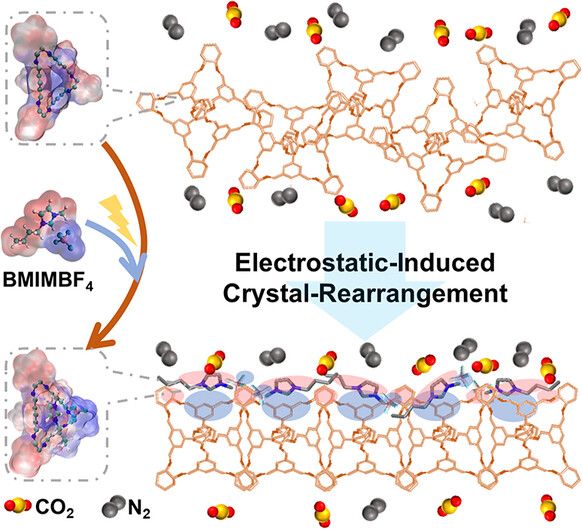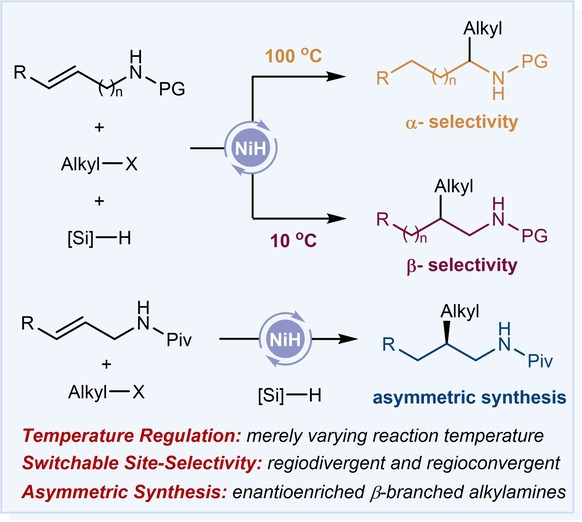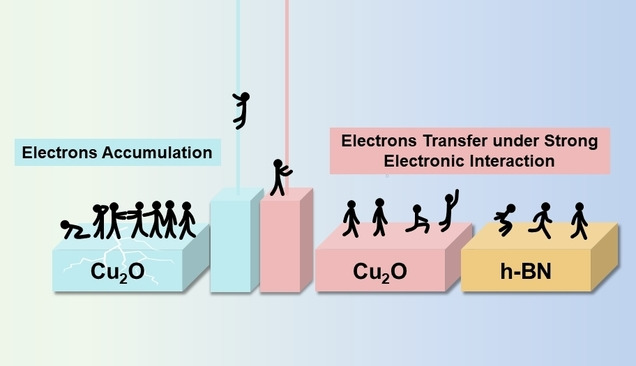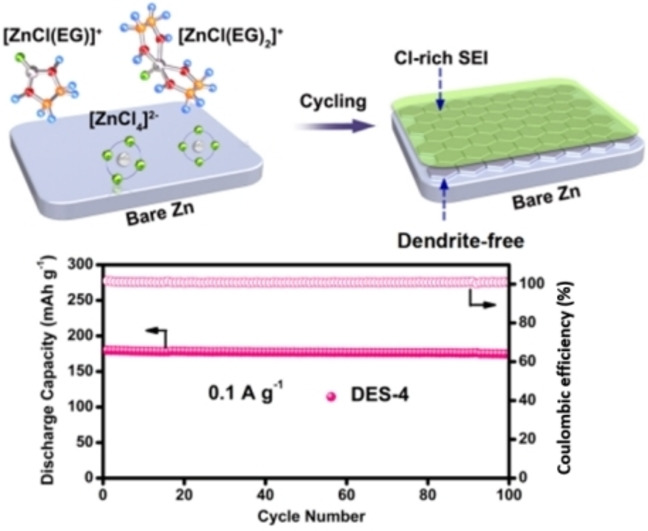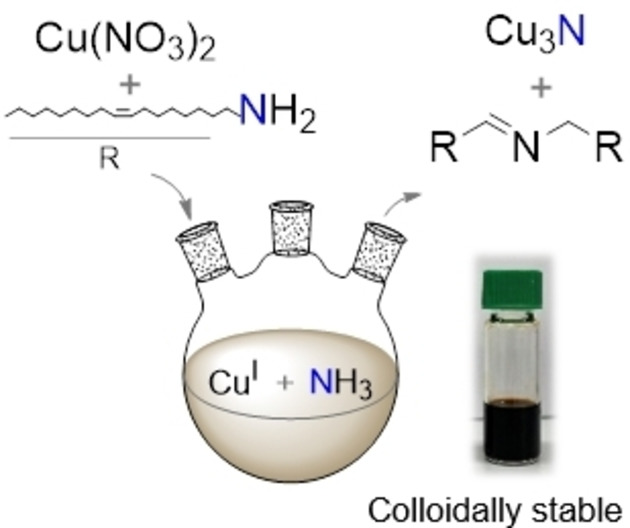Journal list menu
Export Citations
Download PDFs
Cover Pictures
Cover Picture: Sigmatropic [1,5] Carbon Shift of Transient C3 Ammonium Enolates (Angew. Chem. Int. Ed. 31/2022)
- First Published: 13 June 2022
![Cover Picture: Sigmatropic [1,5] Carbon Shift of Transient C3 Ammonium Enolates (Angew. Chem. Int. Ed. 31/2022) Volume 61 Issue 31, 2022](/cms/asset/fda872b3-185a-4637-8928-b3bede91f37e/anie202207944-toc-0001-m.jpg)
The reaction path of the Lewis acid catalyzed intramolecular aza-Michael addition to form a C3 ammonium enolate is reported by Jan Paradies et al. in their Communication (e202204378). This transient intermediate rearranges diastereospecifically to the tetrahydroquinoline-4-one scaffold. The central structure in the picture represents the transition state of the diastereospecific sigmatropic [1,5] carbon shift which proceeds with retention of configuration on the migrating carbon center.
Inside Cover: Porous Organic Salts: Diversifying Void Structures and Environments (Angew. Chem. Int. Ed. 31/2022)
- First Published: 14 June 2022
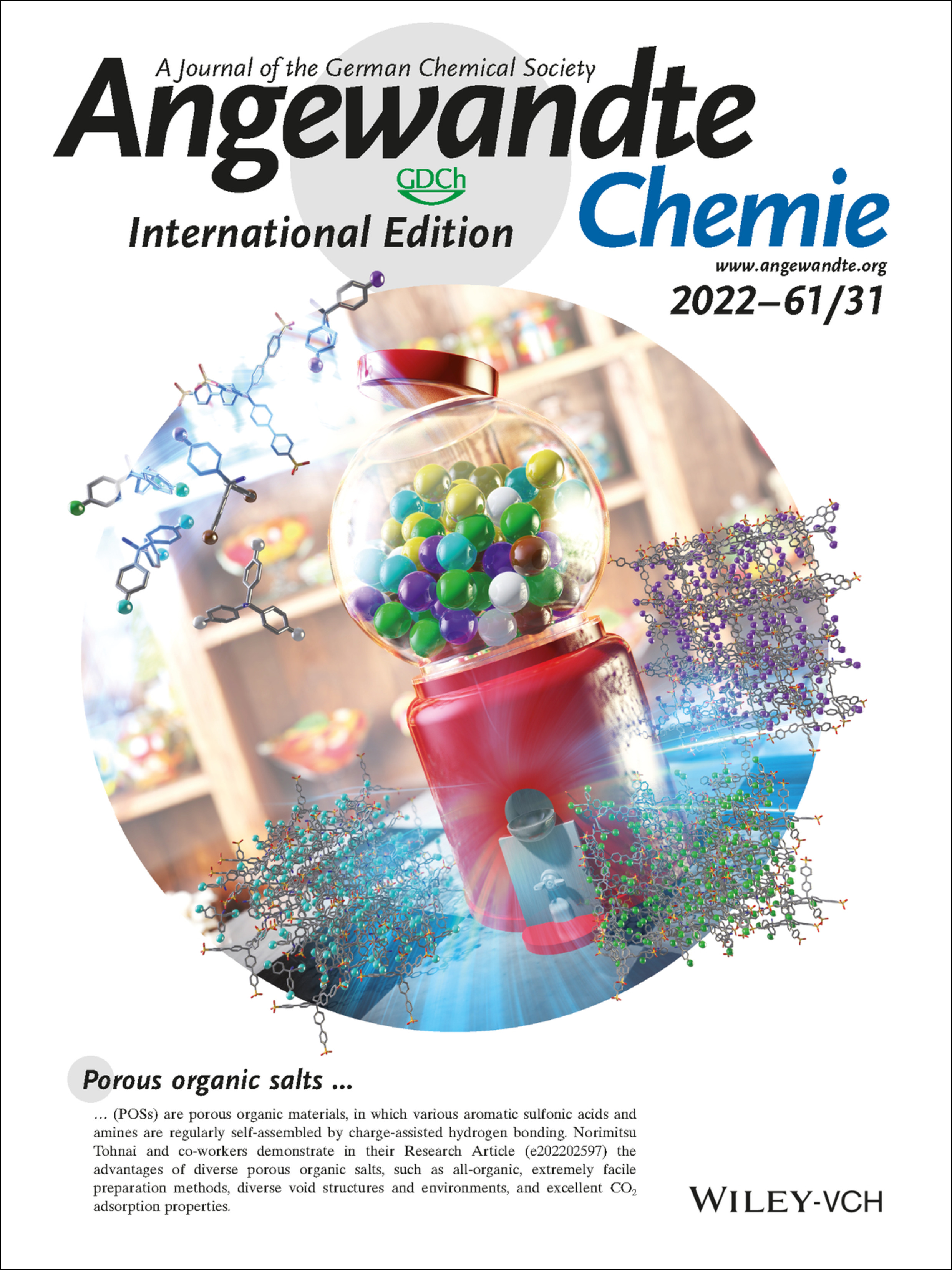
Porous organic salts (POSs) are porous organic materials, in which various aromatic sulfonic acids and amines are regularly self-assembled by charge-assisted hydrogen bonding. Norimitsu Tohnai and co-workers demonstrate in their Research Article (e202202597) the advantages of diverse porous organic salts, such as all-organic, extremely facile preparation methods, diverse void structures and environments, and excellent CO2 adsorption properties.
Inside Back Cover: A DNA Barcode-Based Aptasensor Enables Rapid Testing of Porcine Epidemic Diarrhea Viruses in Swine Saliva Using Electrochemical Readout (Angew. Chem. Int. Ed. 31/2022)
- First Published: 07 July 2022

Rapid and reagent-free pathogen tests are urgently needed. In their Research Article (e202204252), Leyla Soleymani, Yingfu Li and co-workers developed a dual-electrode electrochemical chip (DEE-Chip) and a barcode-releasing electroactive aptamer for rapid on-farm detection of porcine epidemic diarrhea viruses (PEDv). In contrast to current biosecurity surveillance with turnaround times of 2–4 days, this technology identifies infection with PEDv in pig saliva in one hour with a diagnostic sensitivity of 100 % and specificity of 83 %.
Back Cover: Direct Conversion of Syngas to Higher Alcohols via Tandem Integration of Fischer–Tropsch Synthesis and Reductive Hydroformylation (Angew. Chem. Int. Ed. 31/2022)
- First Published: 25 July 2022
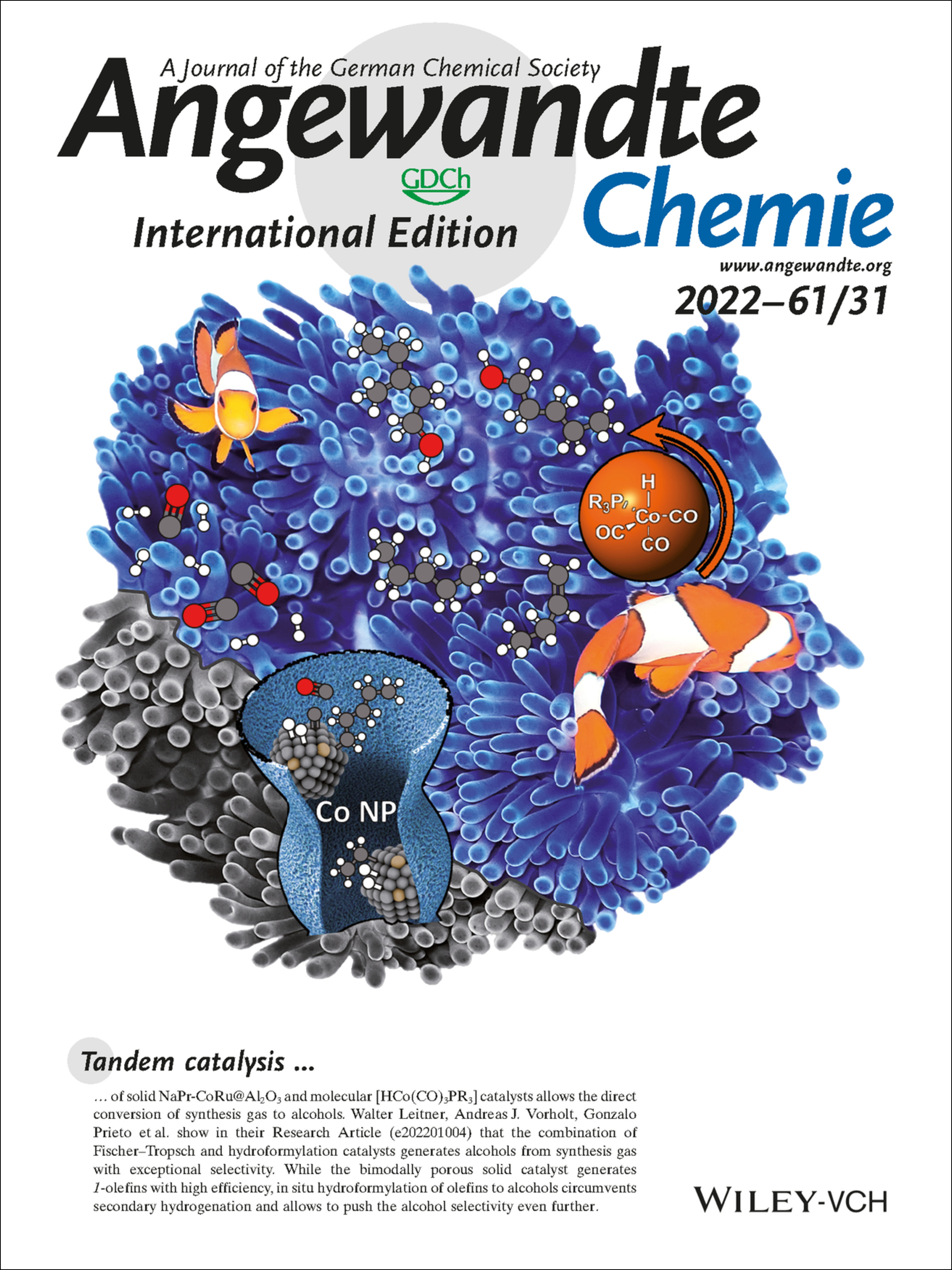
Tandem catalysis of solid NaPr-CoRu@Al2O3 and molecular [HCo(CO)3PR3] catalysts allows the direct conversion of synthesis gas to alcohols. Walter Leitner, Andreas J. Vorholt, Gonzalo Prieto et al. show in their Research Article (e202201004) that the combination of Fischer–Tropsch and hydroformylation catalysts generates alcohols from synthesis gas with exceptional selectivity. While the bimodally porous solid catalyst generates 1-olefins with high efficiency, in situ hydroformylation of olefins to alcohols circumvents secondary hydrogenation and allows to push the alcohol selectivity even further.
Frontispiece
Frontispiece: Towards Upcycling Biomass-Derived Crosslinked Polymers with Light
- First Published: 25 July 2022

Renewable Polymers. In their Communication (e202203353), Mukund P. Sibi, Dean C. Webster, Jayaraman Sivaguru et al. highlight a methodology for the generation of photodegradable and recyclable cross-linked polymers from biomass.
Frontispiece: Water Networks Repopulate Protein–Ligand Interfaces with Temperature
- First Published: 25 July 2022

Protein Structures. By collecting matched room-temperature and cryogenic datasets of the biomedical target Hsp90α, Marcus Fischer et al. identified in their Research Article (e202112919) changes in water networks that impact protein conformations at the ligand binding interface.
Graphical Abstract
Introducing …
Andrew C.-H. Sue
- First Published: 10 June 2022

“The biggest change in my scientific working environment in the past 10 years has been moving to China, a country that I never got chance to explore in the past … I chose chemistry as a career because I liked playing with LEGO® in my childhood. Now I'm just doing the same thing on the molecular level …” Find out more about Andrew Sue in his Introducing … Profile.
Clare Bakewell
- First Published: 14 June 2022

“I'm always in a good mood when I get a really nice crystal structure. I think for an inorganic chemist, this never gets old … My first experiment was probably a complete disaster. And that's fine. Learning to cope with failure is an important part of research …” Find out more about Clare Bakewell in her Introducing … Profile.
Minireviews
Photocatalysis
Visible-Light-Induced, Single-Metal-Catalyzed, Directed C−H Functionalization: Metal-Substrate-Bound Complexes as Light-Harvesting Agents
- First Published: 28 March 2022

Recent advances in photochemical C−H functionalization reactions using a single metal catalyst to enable sustainable strategies for the functionalization of C−H bonds under ambient conditions without an external photosensitizer are highlighted in this Minireview. Reaction mechanisms and the role of visible light are described, and future perspectives and challenges to stimulate future research directions in the field of light-mediated C−H functionalization are discussed.
Fluorine Chemistry
Oxidative Fluorination of Heteroatoms Enabled by Trichloroisocyanuric Acid and Potassium Fluoride
- First Published: 17 May 2022
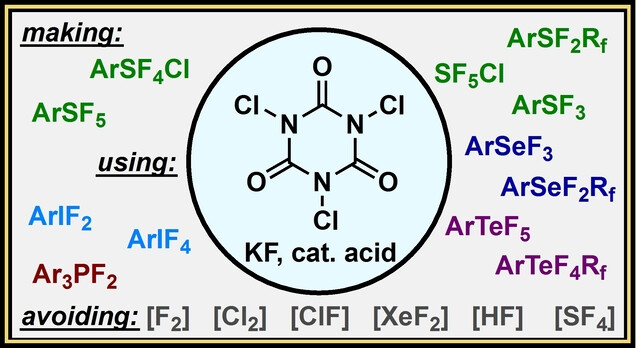
Oxidative fluorination of various Group 15, 16, and 17 heteroatoms in organic scaffolds was made significantly more accessible in recent years using potassium fluoride and trichloroisocyanuric acid (TCICA)—a common swimming pool disinfectant. Behind-the-scenes insight and discussion on discoveries, applications, and opportunities associated with this “TCICA/KF approach” are chronicled herein.
Reviews
Photoswitches
Stepping Out of the Blue: From Visible to Near-IR Triggered Photoswitches
- First Published: 06 May 2022
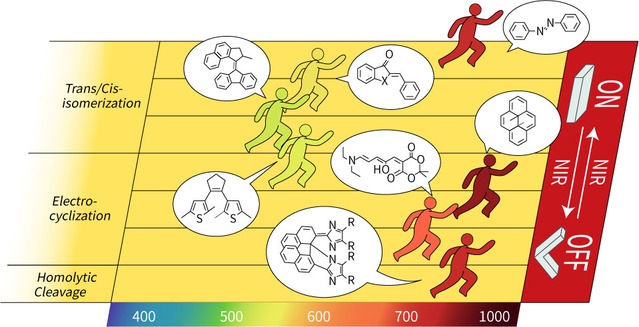
Red-shifted photoswitches are in high demand and have sparked great research interest in the past decade. In this Review, we highlight recent progress towards the development of visible- and NIR-activated photoswitches characterized by distinct photochromic reaction mechanisms. We evaluate the pros and cons of each type based on their photochromic properties and conclude with a perspective on how the field may develop in the future.
Communications
Renewable Polymers | Hot Paper
Towards Upcycling Biomass-Derived Crosslinked Polymers with Light
- First Published: 11 May 2022
Natural Products Synthesis
Total Synthesis of (+)-Cochlearol B by an Approach Based on a Catellani Reaction and Visible-Light-Enabled [2+2] Cycloaddition
- First Published: 13 April 2022
![Total Synthesis of (+)-Cochlearol B by an Approach Based on a Catellani Reaction and Visible-Light-Enabled [2+2] Cycloaddition**](/cms/asset/cdb7d63a-227b-4c2c-b025-88cc404e8e02/anie202201213-toc-0001-m.jpg)
A 14-step approach to (+)-cochlearol B is reported. The strategy involves an organocatalytic Kabbe condensation, Catellani reaction, and visible-light-mediated [2+2] cycloaddition to rapidly access the core of this natural product. Careful design and tuning of the Catellani and photocycloaddition reactions proved crucial in overcoming undesired reactivity, including cyclopropanation reactions, and [4+2] cycloadditions.
Mass Spectrometry | Hot Paper
Native Ambient Mass Spectrometry of an Intact Membrane Protein Assembly and Soluble Protein Assemblies Directly from Lens Tissue
- First Published: 06 June 2022
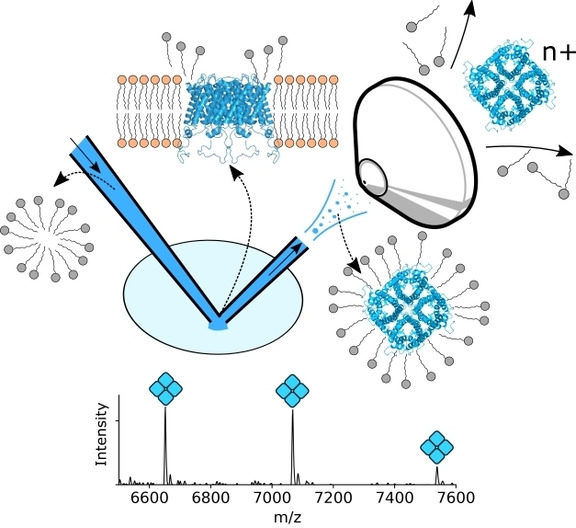
The integral membrane protein assembly Aquaporin-0 was analysed by native ambient mass spectrometry of eye lens tissue. Membrane protein assemblies were solubilised by detergent micelles. Spatially-resolved analysis for mapping protein assembly distributions, accurate intact mass determination, and the identification of assemblies approx. 100 kDa in molecular weight are demonstrated.
Metallo-DNA Structures | Hot Paper
A Novel AgI-DNA Rod Comprising a One-Dimensional Array of 11 Silver Ions within a Double Helical Structure
- First Published: 31 May 2022
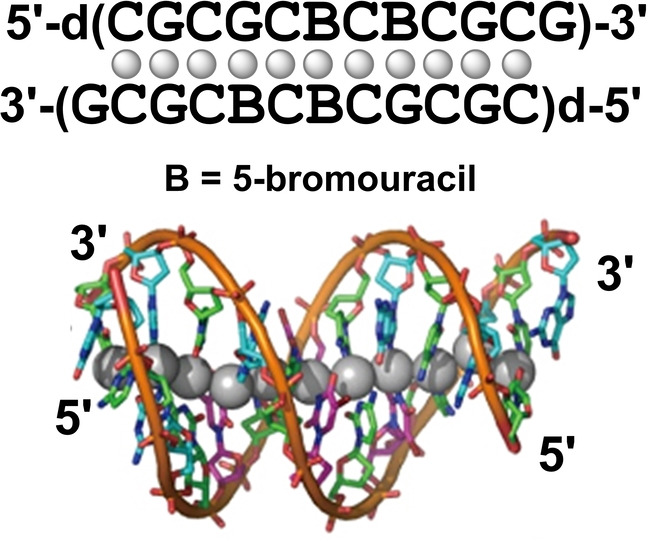
A novel AgI-DNA rod comprising a one-dimensional array of 11 silver ions within a double-helical structure was obtained by mixing an oligonucleotide and silver ions in appropriate solutions. Furthermore, formations of the rod structure in solutions were determined by UV/Vis, CD, NMR, and mass spectrometry.
Natural Products Synthesis | Hot Paper
Organosilanes
Synthesis of Si-Stereogenic Silanols by Catalytic Asymmetric Hydrolytic Oxidation
- First Published: 25 May 2022

A practical method for the catalytic asymmetric synthesis of silicon-stereogenic silanols has been developed. This direct catalytic asymmetric hydrolytic oxidation of dihydrosilanes gives access to a variety of functionalized silicon-stereogenic silanols, including bis-silanols, in high yields with excellent chemo- and stereoselectivity under ambient conditions.
Photocatalysis
Alkyl/Glycosyl Sulfoxides as Radical Precursors and Their Use in the Synthesis of Pyridine Derivatives
- First Published: 31 May 2022
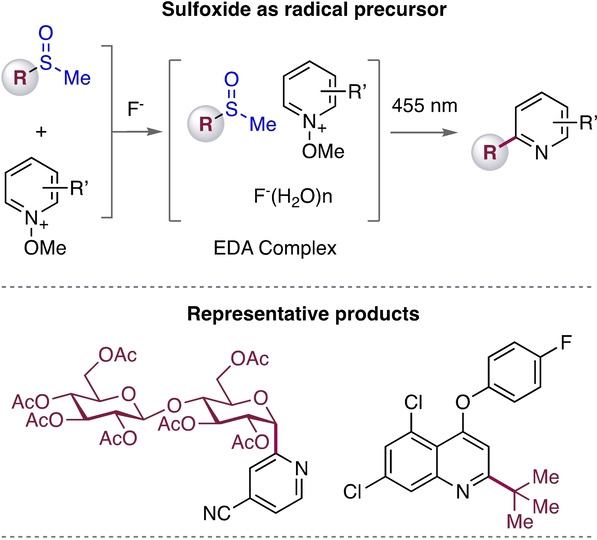
Simple and readily available alkyl sulfoxides are shown to be suitable precursors to radicals. Alkyl sulfoxides, N-methoxy pyridinium salts and fluoride anions form electron donor–acceptor (EDA) complexes, which, upon visible-light irradiation, undergo a radical chain process to give various pyridine derivatives.
Asymmetric Synthesis
A Modular Approach for Diversity-Oriented Synthesis of 1,3-trans-Disubstituted Tetrahydroisoquinolines: Seven-Step Asymmetric Synthesis of Michellamines B and C
- First Published: 26 May 2022

A modular and step-economical approach based on a three-component Catellani reaction and a gold(I)-catalyzed cyclization/reduction cascade has been established for the diversity-oriented synthesis of 1,3-trans-disubstituted tetrahydroisoquinolines. This synthetic strategy enabled concise syntheses of an analogue of the new drug mevidalen as well as four naphthylisoquinoline alkaloids.
Protein Engineering | Hot Paper
Sirtuin-Derived Covalent Binder for the Selective Recognition of Protein Crotonylation
- First Published: 30 May 2022
Photocatalytic CO2 Reduction
Enhanced Photocatalytic CO2 Reduction through Hydrophobic Microenvironment and Binuclear Cobalt Synergistic Effect in Metallogels
- First Published: 25 May 2022
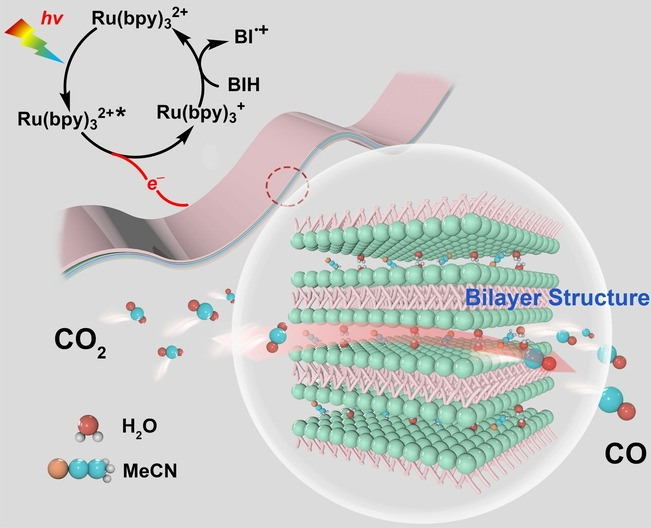
Metallogels based on the co-assembly of L-glutamic acid lipids with cobalt ions can be used as catalysts for photocatalytic CO2 reduction presenting high efficiency and good product selectivity. Mimicking the natural lipid bilayer not only provides these soft matter catalysts with a hydrophobic microenvironment and binuclear synergistic effect but also renders them environmentally friendly with recycling and degradable properties.
Small Molecules Activation | Hot Paper
Synthesis of an N-Heterocylic Boryl-Stabilized Disilyne and Its Application to the Activation of Dihydrogen and C−H Bonds
- First Published: 27 May 2022

The first N-heterocyclic boryl-stabilized disilyne has been prepared and structurally characterized. The disilyne compound enabled the activation of dihydrogen and the benzylic C−H bond from toluene without the need for a catalyst, highlighting the unique electronic effects of the boryl group on the properties of low-valent silicon species.
Low Oxidation State Compounds | Hot Paper
Exploring Equilibria between Aluminium(I) and Aluminium(III): The Formation of Dihydroalanes, Masked Dialumenes and Aluminium(I) Species
- First Published: 27 April 2022

A monomeric AlI compound is used as a stoichiometric reducing agent towards a series of AlIII dihydrides. This leads to the formation of new low oxidation state species including symmetric and asymmetric dihydrodialanes, and a masked dialumene. The transient formation of new, previously inaccessible AlI species is demonstrated through reactivity studies and theory.
Nanoclusters
Fluorescence or Phosphorescence? The Metallic Composition of the Nanocluster Kernel Does Matter
- First Published: 21 May 2022
Photoreduction
Green-Light-Driven Reductive Elimination of Chlorine from a Carbene-Xanthylium Gold(III) Complex
- First Published: 26 May 2022
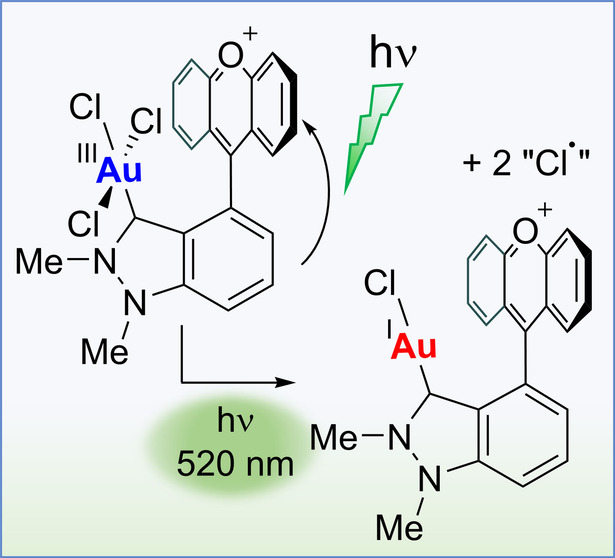
A complex combining an ambiphilic carbene/xanthylium ligand and a gold trichloride supports the efficient green-light-induced extrusion of chlorine radicals en route to the corresponding gold(I) complex. The photolability of this gold(III) complex originates from excitation of a carbene/xanthylium donor/acceptor dyad, the excited state of which challenges the inherent stability of the gold(III) moiety.
Photocatalysis
Formal β-C−H Arylation of Aldehydes and Ketones by Cooperative Nickel and Photoredox Catalysis
- First Published: 03 June 2022
Asymmetric Catalysis | Hot Paper
Enantioselective Hydrocarbamoylation of Alkenes
- First Published: 03 June 2022
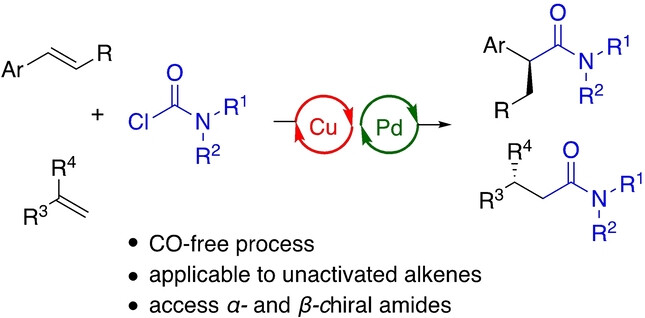
The enantioselective hydrocarbamoylation of alkenes enabled by copper hydride and palladium cooperative catalysis was developed. Utilizing readily available carbamoyl chlorides, this method can be applied to various types of olefins, including alkenyl arenes, terminal alkenes, and 1,1-disubstituted alkenes, providing α- and β-chiral amides in good yields with excellent levels of enantioselectivity.
Chirality Transfer | Hot Paper
Intramolecular Energy and Solvent-Dependent Chirality Transfer within a BINOL-Perylene Hetero-Cyclophane
- First Published: 31 May 2022

A chiral perylene bisimide (PBI) hetero-cyclophane comprising a chiral binaphthol bisimide (BBI) dye and a dynamically racemic PBI dye shows quantitative energy and solvent-dependent chirality transfer among its components, thereby leading to an amplified bright red circularly polarized luminescence from PBI.
Fluorinated COFs | Hot Paper
Microplastics Degradation
Accelerated Degradation of Microplastics at the Liquid Interface of Ice Crystals in Frozen Aqueous Solutions
- First Published: 01 June 2022
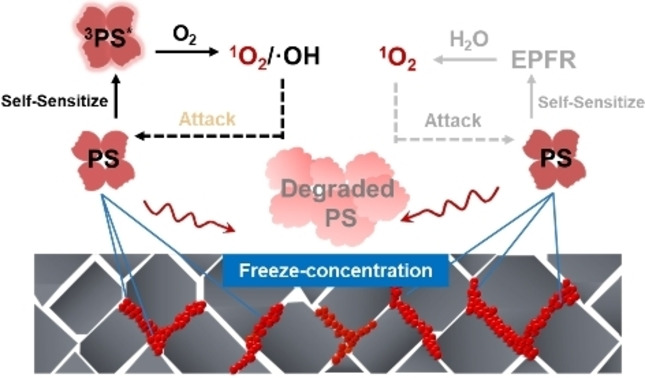
The exceptionally rapid degradation of microplastics (MPs) in frozen solution was discovered. The activity is ascribed to selective generation of singlet oxygen in the narrow space of the liquid layer between ice crystals. The findings offer a highly efficient degradation pathway for MPs and shed light on mechanisms of disposal of MPs in nature.
Amino Acids
Umpolung AlaB Reagents for the Synthesis of Non-Proteogenic Amino Acids, Peptides and Proteins
- First Published: 02 June 2022
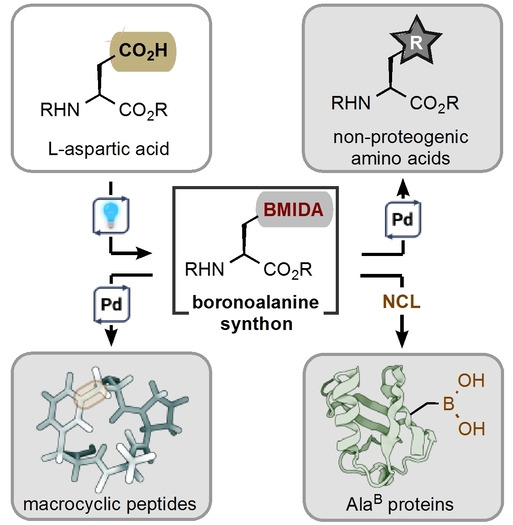
A novel amino acid synthon in the form of boronoalanine (AlaB) suitable for umpolung peptide/protein functionalization is described. It is demonstrated that AlaB can be incorporated into peptides and proteins, and remains stable under solid-phase synthesis, native chemical ligation, and radical desulfurization. Furthermore, AlaB is a competent partner in inter(intra)molecular C(sp3)−C(sp2) cross-couplings.
Photocatalytic CO2 Reduction | Very Important Paper
Reductive Carbon–Carbon Coupling on Metal Sites Regulates Photocatalytic CO2 Reduction in Water Using ZnSe Quantum Dots
- First Published: 29 May 2022
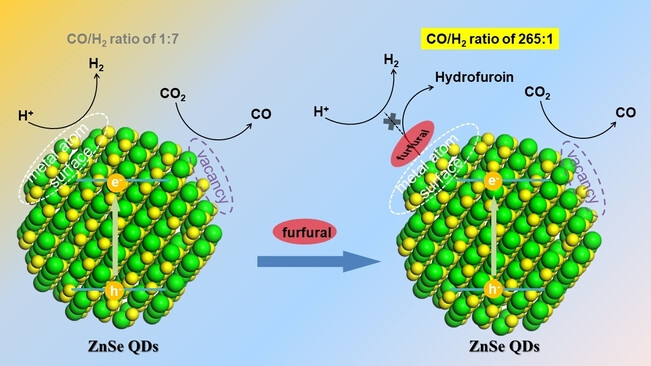
Reductive carbon–carbon coupling was used to block H2 evolution in CO2 photoreduction in water. Furfural, one of the biomass platform molecules, adsorbs on Zn-sites consuming electrons and protons originally used for H2 production, but the CO formation pathway at surface anion vacancies remains. Therefore, CO was evolved with a CO/H2 ratio of 265 : 1 in the gas phase and furfural was upgraded to value-added hydrofuroin.
Organic Synthesis
Sigmatropic [1,5] Carbon Shift of Transient C3 Ammonium Enolates
- First Published: 10 May 2022
![Sigmatropic [1,5] Carbon Shift of Transient C3 Ammonium Enolates](/cms/asset/fab336e8-11eb-4a42-82d3-9c5e93fef527/anie202204378-toc-0001-m.jpg)
The discovery of a new [1,5] sigmatropic rearrangement is described. With the aid of a borane-based Lewis acid, the transiently generated C3 ammonium enolates undergo a sigmatropic [1,5] shift of benzylic, allylic and propargylic groups to provide access to trans-configured tetrahydroquinoline-4-ones with diastereoselectivity of >99 : 1. The reaction is investigated in kinetic, mechanistic and computational experiments.
Metathesis Reactions | Hot Paper
Metathesis Reactions of a NHC-Stabilized Phosphaborene
- First Published: 18 May 2022
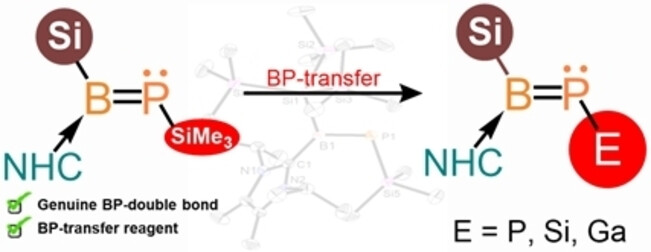
Stable compounds with a genuine B=P double bond are rare and have limited applications given their protecting groups′ bulky nature. The preparation of a Lewis base-stabilized phosphaborene with a B=P double bond and a trimethylsilyl (TMS) functionality at the P-terminal is reported, which exhibits an unprecedented ability for B=P-unit transfer reactions, allowing the isolation of B=P-containing compounds.
Metalation Reactions | Hot Paper
Preparation of Functionalized Amides Using Dicarbamoylzincs
- First Published: 13 May 2022

Polyfunctional dicarbamoylzincs of type (R1R2NCO)2Zn were prepared in THF by treating a mixture of formamides and ZnCl2 with LiTMP (THF, 15 °C, 15 min) or by reacting formamides with TMP2Zn (THF, 25 °C, 16 h). These zinc reagents reacted with allylic, benzylic, aryl and alkenyl bromides, acid chlorides, aldehydes or enones providing various amides in 47–97 % yields. 13C NMR data showed a characteristic carbonyl signal at 219.4 ppm for (Bu2NCO)2Zn.
Aromaticity | Hot Paper
A Planar Five-Membered Aromatic Ring Stabilized by Only Two π-Electrons
- First Published: 20 May 2022
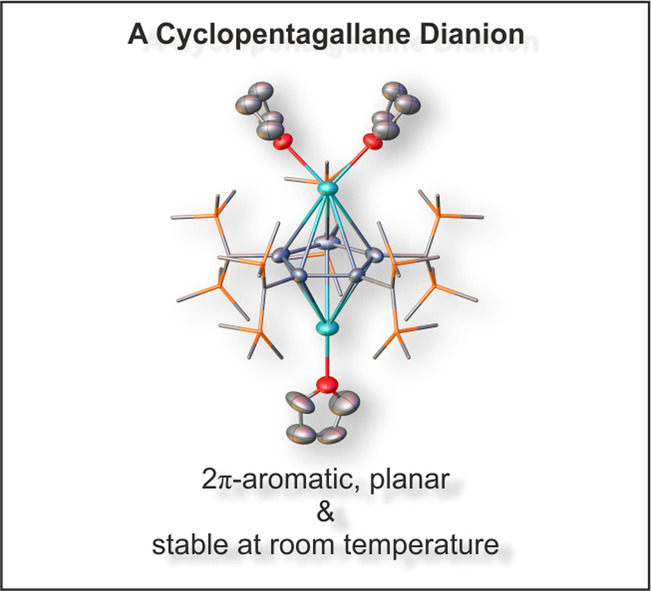
Although doubted in the past, two π-electrons are just enough to stabilize five-membered aromatic compounds that are even stable at room-temperature, as shown by the facile synthesis of a dipotassium cyclopentagallene. This compound is a unique example of a five-membered aromatic ring stabilized by only two π-electrons. Single-crystal X-ray diffraction revealed a planar Ga5 ring with almost equal gallium–gallium bond lengths.
Research Articles
Protein Structures
Water Networks Repopulate Protein–Ligand Interfaces with Temperature
- First Published: 01 June 2022
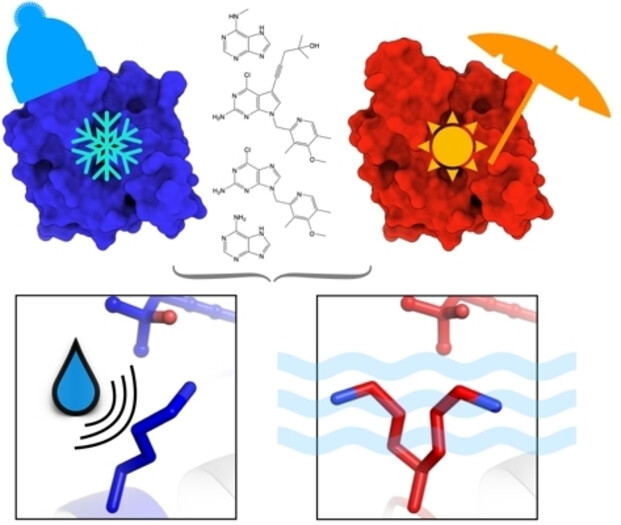
Cryo-cooled water molecules block protein motions that impact protein–ligand interactions. Paired cryo and room-temperature comparisons of ligand-bound Hsp90α structures show that water networks and protein conformations are more mobile at room temperature. Revealing such alternate conformational states that are masked by cryo-cooling provides new insights towards drug discovery.
Ferroptosis | Very Important Paper
Ternary Alloy PtWMn as a Mn Nanoreservoir for High-Field MRI Monitoring and Highly Selective Ferroptosis Therapy
- First Published: 23 April 2022
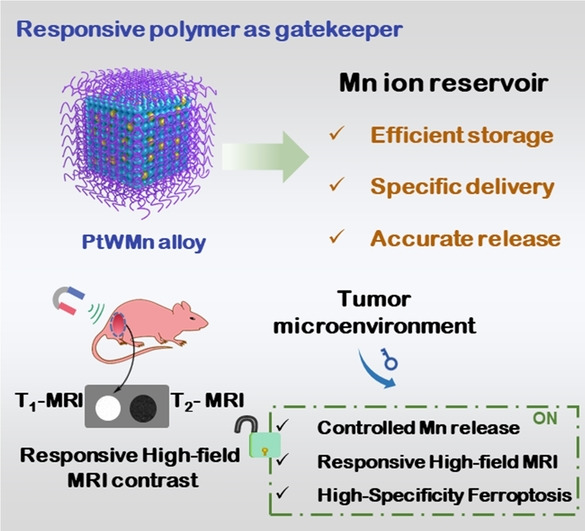
A novel ternary alloy PtWMn nanoplatform is developed as a Mn reservoir that exhibits efficient storage, specific delivery and accurate release of Mn ions for high-specificity ferroptosis-based cancer therapy. Such a smart nanoplatform can exert a responsive imaging signal in dual-mode (T1- or T2-weighted) high-field MRI, which enables the real-time monitoring of Mn release within the tumor microenvironment and of ferroptosis initiation.
Syngas to Alcohols
Direct Conversion of Syngas to Higher Alcohols via Tandem Integration of Fischer–Tropsch Synthesis and Reductive Hydroformylation
- First Published: 01 May 2022
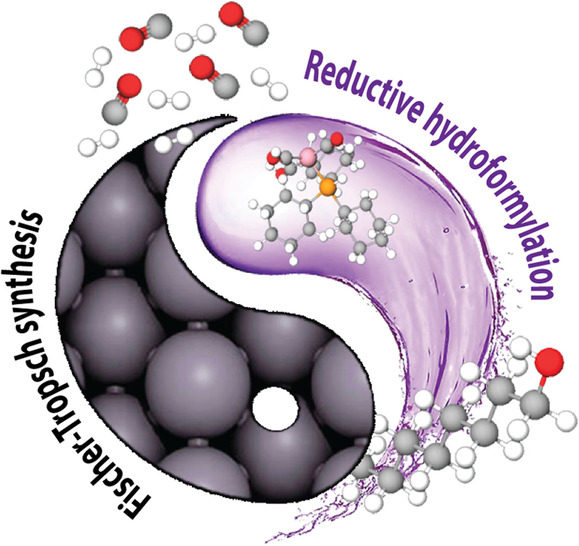
Catalyst engineering enables the single-pot integration of solid nanoparticulate and molecular cobalt catalysts in a slurry-phase tandem Fischer–Tropsch synthesis/olefin reductive hydroformylation process for a direct and highly selective conversion of syngas (H2/CO) to higher alcohols. The new tandem process contributes to bridging the traditionally dissevered disciplines of heterogeneous and homogeneous catalysis.
Carbene Chemistry
“Sandwich” Diimine-Copper Catalysts for C−H Functionalization by Carbene Insertion
- First Published: 20 May 2022

A new catalyst platform for C(sp3)−H bond functionalization has been discovered. “Sandwich” diimine-copper(I) complexes catalyze reactions of alkane, ether, and amine C−H bonds with a large panel of diazo compounds. Additionally, the first metal-catalyzed C(sp3)−H methylation by CH2N2 is disclosed. The electrophilicity and extreme steric bulk of these catalysts are likely reasons for their efficiency.
Aptamer
Engineering Aptamers with Selectively Enhanced Biostability in the Tumor Microenvironment
- First Published: 10 May 2022

Aptamer sgc8c equipped with an ATP-responsive protection module, termed ARP-sgc8c, was designed. ARP-sgc8c could be selectively protected from nuclease degradation in the tumor microenvironment through specific incorporation along with high-concentration ATP, while its rapid degradation was maintained in healthy tissues.
Palladium Catalysis
S,O-Ligand Promoted meta-C−H Arylation of Anisole Derivatives via Palladium/Norbornene Catalysis
- First Published: 31 May 2022

A highly efficient meta-selective C−H arylation of aryl ethers has been realized by a new catalytic system based on palladium/norbornene (Pd/NBE) and an S,O-ligand. The reaction proceeds with a broad range of aryl ethers. For the first time, unsymmetrical meta-diarylation of aryl ethers was accomplished using a novel norbornene. The isolation of palladium intermediates provides insight to the mechanism.
Biocatalysis
Chemoenzymatic Cascades for the Enantioselective Synthesis of β-Hydroxysulfides Bearing a Stereocentre at the C−O or C−S Bond by Ketoreductases
- First Published: 16 May 2022
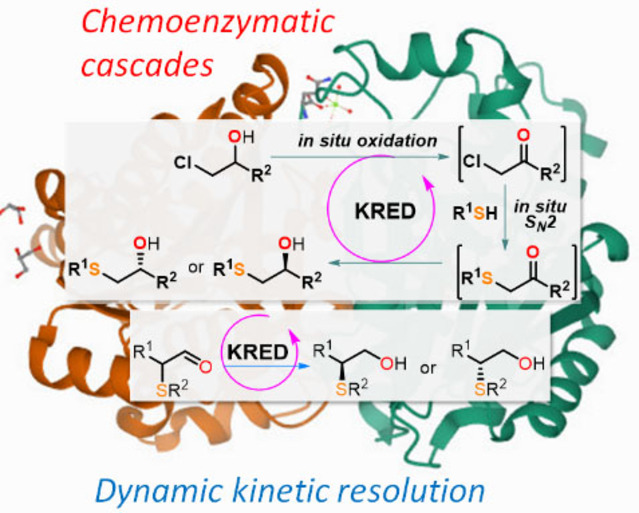
Four ketoreductases (KREDs) were identified for the enantioselective synthesis of β-hydroxysulfides. KRED311 and KRED349 catalyse the synthesis of β-hydroxysulfides bearing a stereocentre at the C−O bond with opposite absolute configurations via chemoenzymatic cascades from thiophenols/thiols and α-haloketones/alcohols. KRED253 and KRED384 catalyse the synthesis of β-hydroxysulfides bearing a stereocentre at the C−S bond with opposite enantioselectivities by dynamic kinetic resolution (DKR) of racemic α-thioaldehydes.
Phosphorescent Materials | Very Important Paper
Sustainable Afterglow Room-Temperature Phosphorescence Emission Materials Generated Using Natural Phenolics
- First Published: 07 April 2022
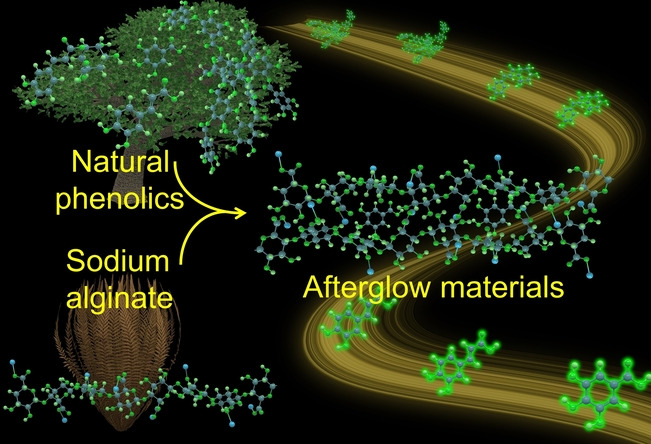
Sustainable organic afterglow room-temperature phosphorescence (RTP) with long lifetime is a particularly attractive phenomenon but remains difficult to achieve. Here, we prepared sustainable afterglow RTP materials (GA@SA) with a lifetime up to 934.7 ms by embedding gallic acid (GA) within a Ca2+-crosslinked sodium alginate (SA) matrix.
Organic Crystals
Porous Organic Salts: Diversifying Void Structures and Environments
- First Published: 03 May 2022
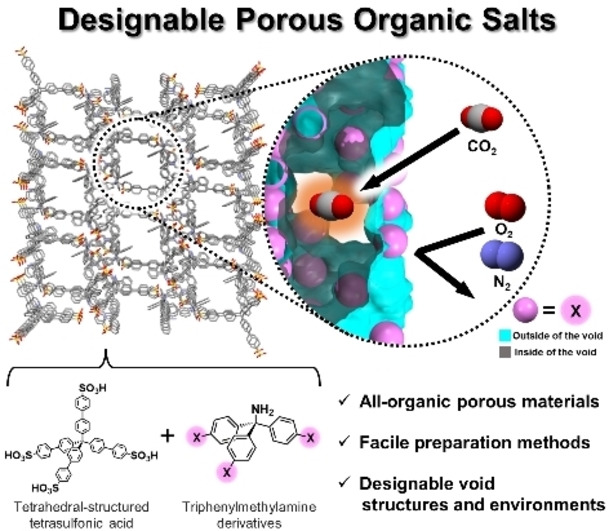
Various aromatic sulfonic acids and amines were self-assembled by charge-assisted hydrogen bonding to form porous organic salts. This study demonstrates the advantages of diverse porous organic salts, such as all-organic, extremely facile preparation methods, diverse void structures and environments, and excellent CO2 adsorption properties.
Total Synthesis
Concise Synthesis of Tunicamycin V and Discovery of a Cytostatic DPAGT1 Inhibitor
- First Published: 20 May 2022

A Büchner–Curtius–Schlotterbeck-type reaction enabled the total synthesis of tunicamycin V (TN-V), a nonselective phosphotransferase inhibitor, in just 15 steps from D-galactal in 21 % overall yield. The short and high-yielding synthetic route was also adapted for the synthesis of analogues, thus leading to the discovery of a novel cytostatic tunicamycin analogue, TN-TMPA, with high DPAGT1 selectivity.
Immunochemistry
Restoration of the Immunogenicity of Tumor Cells for Enhanced Cancer Therapy via Nanoparticle-Mediated Copper Chaperone Inhibition
- First Published: 01 June 2022

A combination strategy for synergistic chemo-sensitization and conversion of tumor cells into vaccines triggers an intense immune response through copper chaperone inhibition with multifunctional nanoparticles loaded with cisplatin prodrugs and DC_AC50 conjugated to reactive oxygen species (ROS)-responsive polymers.
Interfaces | Hot Paper
Polarization-Dependent Ultrasensitive Dynamic Wrinkling on Floating Films Induced by Photo-Orientation of Azopolymer
- First Published: 25 May 2022
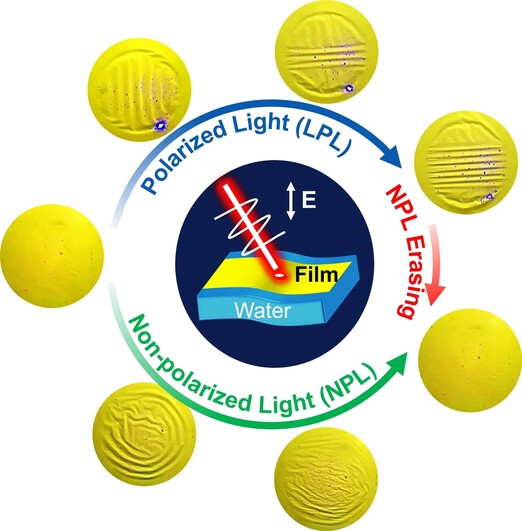
During polarized light illumination, a floating azo-film experiences a wealth of ultrafast wrinkling evolution coupled with unprecedented sequential wrinkling orientation conversion (from polarization-parallel to polarization-perpendicular). The different polarization-dependent sequential photo-orientation for azo side chains and azo-grafted main chains of azopolymers that are involved is revealed experimentally for the first time.
Aqueous Batteries
From Copper to Basic Copper Carbonate: A Reversible Conversion Cathode in Aqueous Anion Batteries
- First Published: 06 May 2022
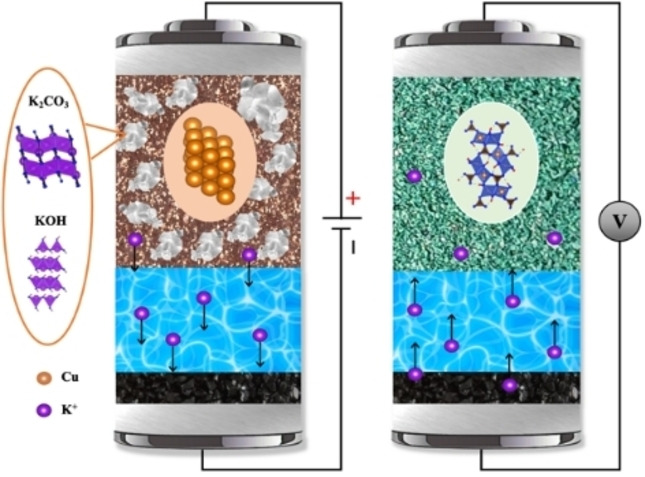
The highly reversible electrochemical conversion of commercial bulk copper metal to form basic copper carbonate, Cu2CO3(OH)2, from a saturated aqueous electrolyte comprising 4.5 m K2CO3 and 9 m KOH, demonstrating high capacity, fast rate capability, and relatively stable cycle life is reported. The salt electrode consisting of Cu, K2CO3, and KOH renders this anion-hosting electrode a cathode for rocking-chair batteries.
Electrochemical Neutralization Cell | Very Important Paper
Hydrogen Production and Water Desalination with On-demand Electricity Output Enabled by Electrochemical Neutralization Chemistry
- First Published: 22 April 2022
Zeolite Catalysis
Highly Selective Carbonylation of CH3Cl to Acetic Acid Catalyzed by Pyridine-Treated MOR Zeolite
- First Published: 30 May 2022
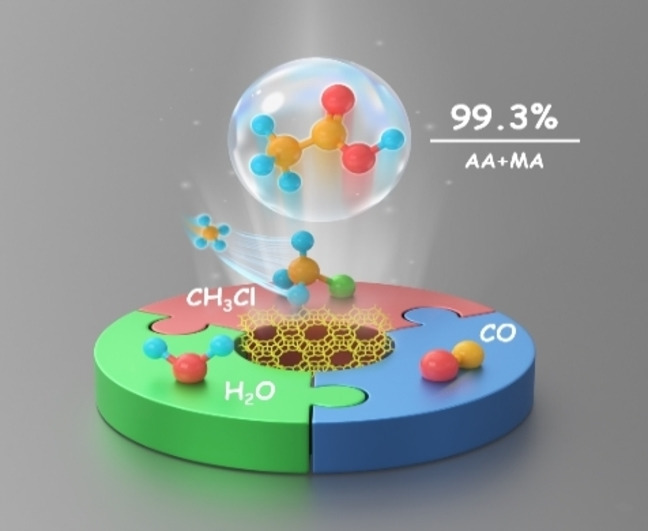
An innovative reaction strategy for the transformation of methane into acetic acid via CH3Cl carbonylation over H-zeolites is reported. A 99.3 % acetic acid (AA) and methyl acetate (MA) selectivity was obtained over pyridine-pretreated MOR at 523 K and 2.0 MPa. This strategy enables efficient conversion of methane into oxygenates under mild conditions.
Electroanalytical Chemistry
Fast-Scanning Potential-Gated Organic Electrochemical Transistors for Highly Sensitive Sensing of Dopamine in Living Rat Brain
- First Published: 18 May 2022

We have demonstrated the first fast-scanning potential-gated organic electrochemical transistor (FSP-OECT) for in vivo dopamine (DA) sensing, featuring high sensitivity, selectivity, reproducibility, and stability. It was successfully applied for in vivo DA sensing at low basal levels as well as the electrically stimulated release of DA.
Biosensors | Very Important Paper
A DNA Barcode-Based Aptasensor Enables Rapid Testing of Porcine Epidemic Diarrhea Viruses in Swine Saliva Using Electrochemical Readout
- First Published: 13 May 2022
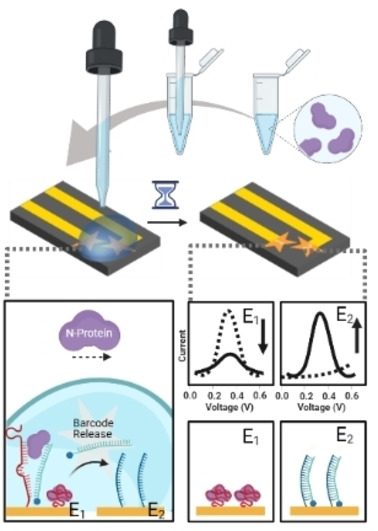
A rapid, simple, and reagent-less dual-electrode electrochemical chip (DEE-Chip) was developed using a barcode-releasing electroactive aptamer for on-farm detection of porcine epidemic diarrhea viruses (PEDv). This biosensor demonstrated a diagnostic sensitivity of 83 % and specificity of 100 % using 12 porcine saliva samples with a concordance value of 92 % at an analysis time of one hour.
Hydroboration
Ruthenium-Catalyzed Geminal Hydroborative Cyclization of Enynes
- First Published: 21 May 2022

Different from the previously known hydroborative cyclizations that add hydrogen and boron to opposite sides of an enyne, the proper choice of a ruthenium catalyst alters this propensity to a new addition mode, geminal hydroborative cyclopropanation. Two possible mechanisms are operative, which are substrate-dependent based on DFT studies.
Pillararenes
Molecular Junctions
Bipolar Magnetic Molecules for Spin-Polarized Electric Current in Molecular Junctions
- First Published: 26 May 2022
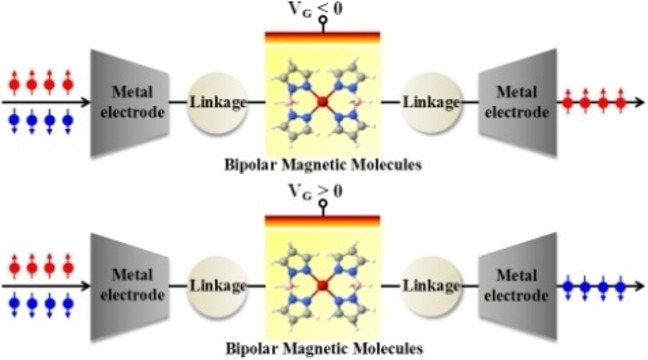
An efficient method to manipulate electron spin orientation in single molecule devices by electrical gating is reported. The realization of such a function is based on a special class of molecules, named bipolar magnetic molecules (BMMs), which are characterized by their unique energy level arrangement, i.e. HOMO and LUMO come from two different spin channels.
Li-Metal Batteries | Very Important Paper
Li−N Interaction Induced Deep Eutectic Gel Polymer Electrolyte for High Performance Lithium-Metal Batteries
- First Published: 25 May 2022
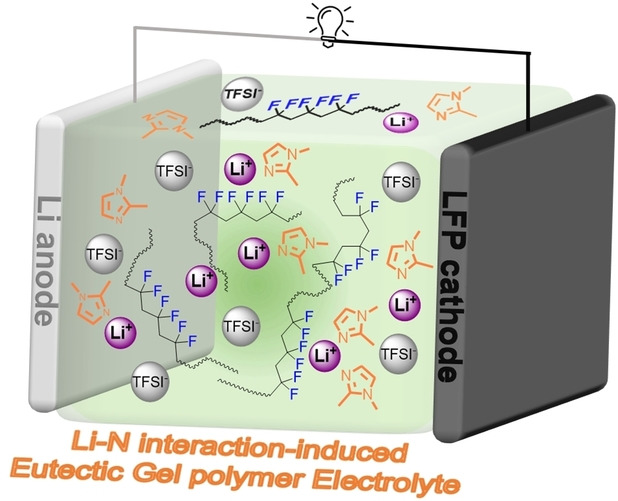
A new Li−N interaction induced 1,2-dimethylimidazole (DMIm)-based deep eutectic gel polymer electrolyte is reported. The electron-donating DMIm dissociates LiTFSI well to form a deep eutectic electrolyte (DEE). The incorporation of polyvinylidene difluoride (PVDF) further changes the coordination environment of the Li+ ions. This kind of gel polymer electrolyte exhibits high ionic conductivity and electrochemical stability and enables the excellent long-term cycling performance for Li/LFP cells.
Atropisomers
Biosensors | Hot Paper
Mild Acidosis-Directed Signal Amplification in Tumor Microenvironment via Spatioselective Recruitment of DNA Amplifiers
- First Published: 01 June 2022
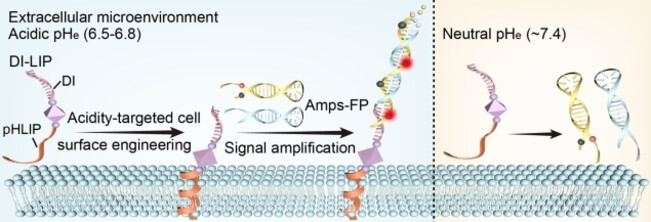
A DNA-based strategy is developed for spatially-selective amplification of acidic signals in the extracellular milieu of tumors. Amplified imaging of the tumor microenvironment with improved sensitivity was achieved by acidity-responsive engineering of the cell surface with DNA receptors for controlled recruitment of fluorescent amplifiers.
Porous Organic Cages | Hot Paper
Electrostatic-Induced Crystal-Rearrangement of Porous Organic Cage Membrane for CO2 Capture
- First Published: 30 May 2022
Nickel Catalysis | Hot Paper
Nickel-Catalyzed Switchable Site-Selective Alkene Hydroalkylation by Temperature Regulation
- First Published: 24 May 2022
P-Heterocycles
Straightforward Access to Multifunctional π-Conjugated P-Heterocycles Featuring an Internal Ylidic Bond
- First Published: 03 June 2022
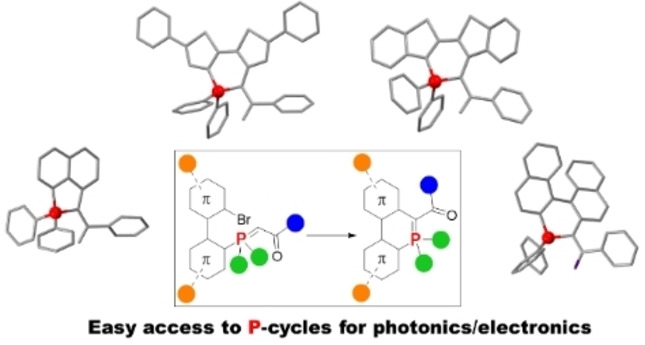
A simple synthesis of P-heterocycles featuring an internal ylidic bond is reported. The stability of the compounds tolerates post-functionalization (direct arylation) and the strategy is also compatible with the preparation of polyaromatic scaffolds (acenes, helicenes). Molecular engineering allows tuning the optical and redox properties, making them valuable dyes for a large panel of photonic or opto-electronic applications.
Organometallic Chemistry | Hot Paper
Formation of a Hybrid 1-Bora-3-boratabenzene Heteroarene Anion Derivative
- First Published: 21 May 2022
Superimposed Fluorescence
Ultrafast Triplet–Singlet Exciton Interconversion in Narrowband Blue Organoboron Emitters Doped with Heavy Chalcogens
- First Published: 26 May 2022
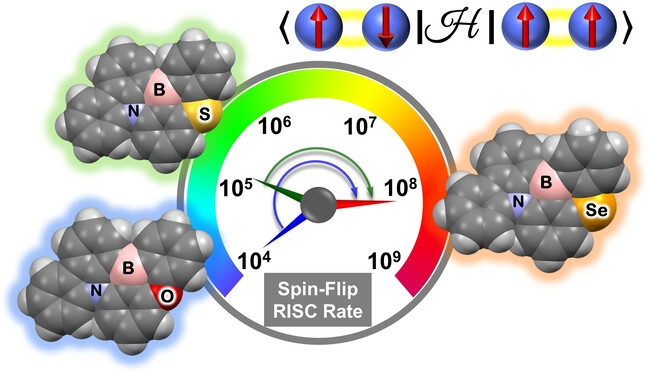
A selenium-doped polycyclic organoboron emitter exhibits ultrafast triplet–singlet exciton interconversion ability in addition to strong narrowband blue emission. Its spin-flip reverse intersystem crossing (RISC) rate exceeds 108 s−1 (100 million times spin inversion per second), enabling superimposed fluorescence with full exciton utilization. This breakthrough shatters the stereotypical physicochemical views of conventional thermally activated delayed fluorescence limited by slow RISC.
Organic Semiconductors | Hot Paper
Precision Synthesis of Various Low-Bandgap Donor–Acceptor Alternating Conjugated Polymers via Living Suzuki–Miyaura Catalyst-Transfer Polymerization
- First Published: 01 June 2022
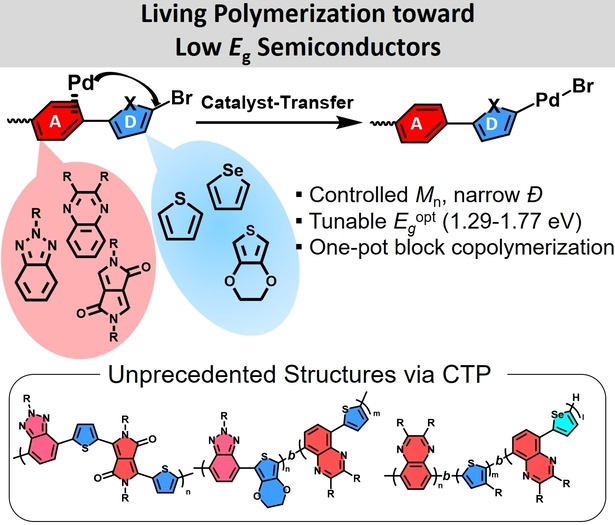
Donor–acceptor alternating conjugated polymers with various electronic characteristics, including strong donor–strong acceptor, are synthesized via living Suzuki–Miyaura catalyst-transfer polymerization in a controlled manner. The polymerization also works with a complex quateraryl monomer and allows for one-pot di(tri)block copolymer synthesis. The resulting polymers have tunable optical and electrochemical properties based on the combination of building units.
CO2 Reduction
Stabilization of Cu+ via Strong Electronic Interaction for Selective and Stable CO2 Electroreduction
- First Published: 30 May 2022
Cathode Materials
Highly Active and Stable Li2S−Cu Nanocomposite Cathodes Enabled by Kinetically Favored Displacement Interconversion between Cu2S and Li2S
- First Published: 01 June 2022
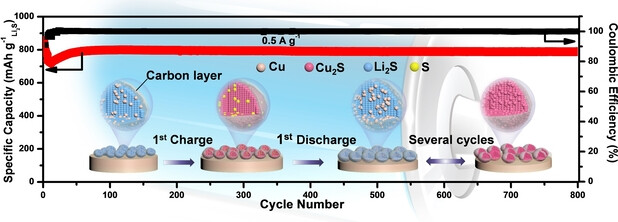
A nanostructured Li2S−Cu composite is fabricated and it is demonstrated that Cu progressively participates in the redox processes and fundamentally alters the redox couple from anion-type Li2S/S to cation-type Cu/Cu2S, which leads to a drastically reduced activation potential (2.35 V vs. Li+/Li), superior rate capability, and stable long-term cycling performance.
Electrocatalytic Urea Oxidation
Activating Lattice Oxygen in Layered Lithium Oxides through Cation Vacancies for Enhanced Urea Electrolysis
- First Published: 18 May 2022
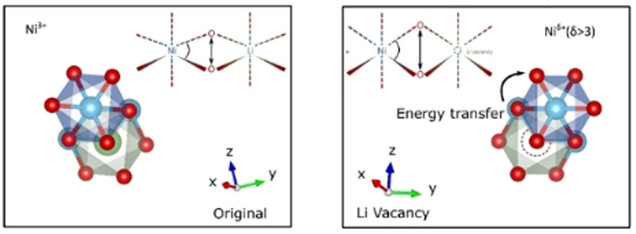
Beginning with cation-vacancy controllable LiNiO2, the origin of the high performance and the structure–activity correlations was studied. The results indicate that lattice oxygen activated by cation vacancies triggered charge disproportionation to form high-activity Ni4+, resulting in facilitating deprotonation in a lattice oxygen involved catalytic process.
Peptide Ligation
PIII-Directed Late-Stage Ligation and Macrocyclization of Peptides with Olefins by Rhodium Catalysis
- First Published: 23 May 2022
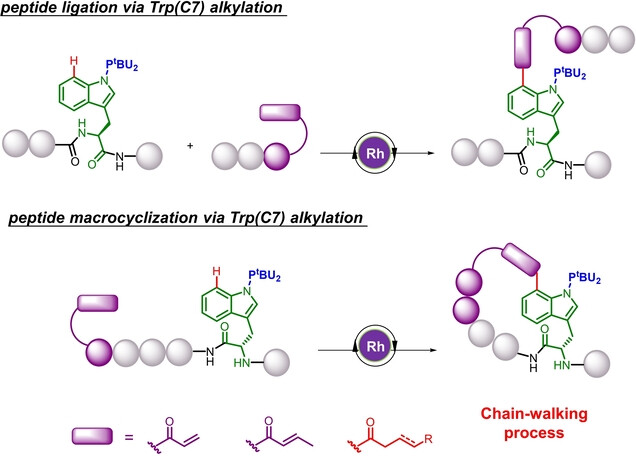
A method for late-stage peptide ligation and macrocyclization through rhodium-catalyzed C7-selective alkylation of tryptophan residues has been developed. This method is compatible with internal olefins and represents the first example of site-selective peptide C−H alkylation through deconjugative isomerization.
CO2 Reduction | Hot Paper
Bioinspired Metalation of the Metal-Organic Framework MIL-125-NH2 for Photocatalytic NADH Regeneration and Gas-Liquid-Solid Three-Phase Enzymatic CO2 Reduction
- First Published: 18 May 2022
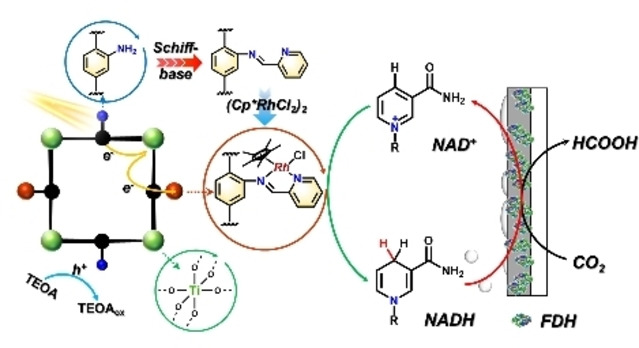
Bioinspired metalation of the MOF MIL-125-NH2 was accomplished by incorporating the electron-transfer unit of a Rh complex for facilitated photocatalytic NADH regeneration. By immobilizing formate dehydrogenase onto the hydrophobic layer of the membrane, a gas-liquid-solid three-phase interface around the enzyme site could be formed for sustained and enhanced formic acid production coupled with in situ generated NADH.
Atropisomerism | Hot Paper
Atroposelective Construction of Nine-Membered Carbonate-Bridged Biaryls
- First Published: 27 May 2022

An efficient method for the atroposelective construction of nine-membered carbonate-bridged biaryls was achieved through a ring-expansion process via vinylidene ortho-quinone methide (VQM) intermediates. This strategy allows the convenient construction of bridged biaryls with broad functional group tolerance under mild conditions. In bioassay studies, several agents showed considerable antiproliferative activity via the mitochondrial-related apoptosis mechanism.
Zn-Ion Batteries
Eutectic Electrolyte with Unique Solvation Structure for High-Performance Zinc-Ion Batteries
- First Published: 24 May 2022
Silver Nanoclusters | Hot Paper
An Ultrastable 155-Nuclei Silver Nanocluster Protected by Thiacalix[4]arene and Cyclohexanethiol for Photothermal Conversion
- First Published: 19 May 2022
![An Ultrastable 155-Nuclei Silver Nanocluster Protected by Thiacalix[4]arene and Cyclohexanethiol for Photothermal Conversion](/cms/asset/e29054fb-d253-446e-bf61-ee7cc840b869/anie202206742-toc-0001-m.jpg)
An unusual C5h-symmetric silver nanocluster (Ag155) with the highest reported nuclearity was prepared by exploiting the protection of the macrocyclic ligand p-tert-butylthiacalix[4]arene (H4TC4A) and cyclohexanethiol (CySH). This silver nanocluster exhibits excellent stability in solution and photothermal conversion efficiency.
Fluorescent MOFs | Hot Paper
Sila-Adamantanes | Hot Paper
Site-Selective Functionalization of Sila-Adamantane and Its Ensuing Optical Effects
- First Published: 23 May 2022
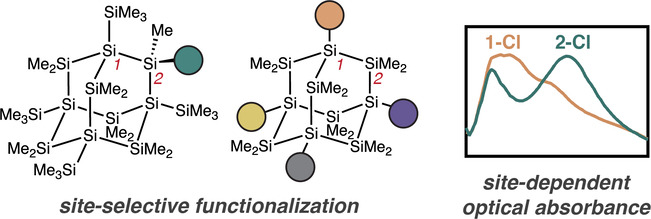
Mechanistic insight into the isomerization synthesis of sila-adamantane enables the regioselective functionalization of sila-adamantane at its 1-, 2-, 3-, 5-, and 7-positions. Substitution at the 1-position of the cluster core significantly impacts optical absorbance relative to exocyclic or 2-substitution.
Receptor Targeting | Hot Paper
Tailored Multivalent Targeting of Siglecs with Photosensitizing Liposome Nanocarriers
- First Published: 02 June 2022
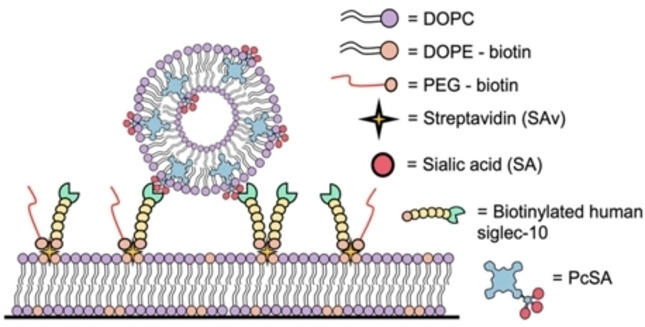
A promising approach towards optically active biohybrid systems that selectively bind receptors of the sialic acid-binding immunoglobulin-like lectins (siglecs) family is described. To this end, siglec-modified supported lipid bilayers act as cell membrane mimics that interact in a multivalent fashion with photosensitizer-loaded vesicles, showing a potential for targeting siglec-expressing cells with photosensitizing nanocarriers.
Nitride Nanocrystal Synthesis
Li-Ion Batteries
Mesoporous Polyimide-Linked Covalent Organic Framework with Multiple Redox-Active Sites for High-Performance Cathodic Li Storage
- First Published: 30 May 2022
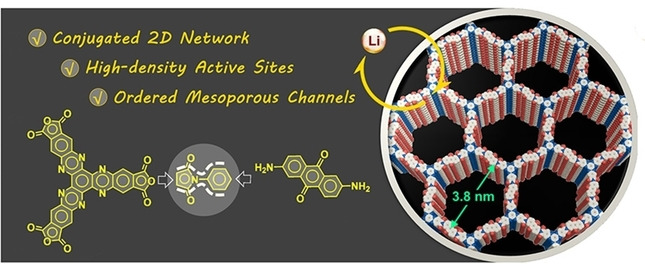
A two-dimensional polyimide-linked covalent organic framework (COF) with high loading density of redox-active centers and a mesoporous channel for facile Li+-ion diffusion has been designed and fabricated, exhibiting one of the best performances among the thus far reported COF-based cathodes for Li-ion batteries.
Gold Nanoclusters
Asymmetrically Doping a Platinum Atom into a Au38 Nanocluster for Changing the Electron Configuration and Reactivity in Electrocatalysis
- First Published: 30 May 2022
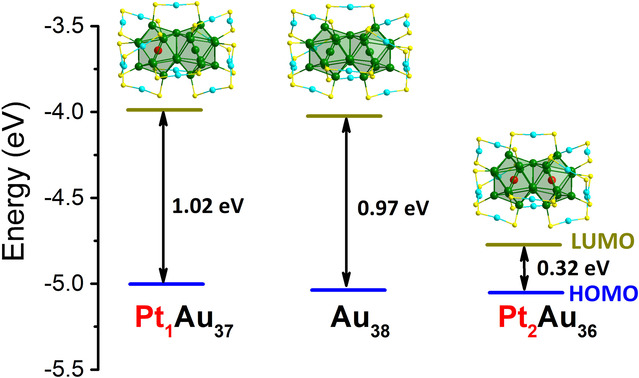
Pt1Au37(SCH2PhtBu)24 and Pt2Au36(SCH2PhtBu)24 nanoclusters are prepared by doping one and two Pt atoms into the kernels of Au38(SCH2PhtBu)24.This study provides an opportunity for systematically investigating the electron configuration change of the nanoclusters in the consecutive doping process and shows the order of electrocatalytic activity: Pt1Au37 > Au38 > Pt2Au36.
Circular Dichroism
Spatiotemporal Mapping of Efficient Chiral Induction by Helicene-Type Additives in Copolymer Thin Films
- First Published: 16 May 2022
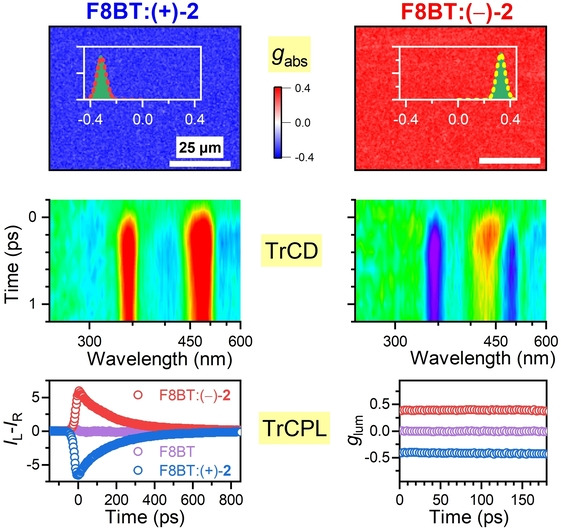
A special class of helicene-type additives, which are straightforward to synthesize in large amounts, induce strong chirality in polyfluorene copolymer thin films. Advanced chirality-sensitive microscopy techniques and ultrafast time-resolved spectroscopic methods based on transient circular dichroism and transient circularly polarized luminescence reveal the supramolecular origin of the chiroptical properties.
Biocatalysis
A Deep Eutectic Solvent Thermomorphic Multiphasic System for Biocatalytic Applications
- First Published: 19 May 2022

The applicability of a deep eutectic solvent thermomorphic multiphasic system (DES-TMS) within biocatalysis was successfully demonstrated. Horse liver alcohol dehydrogenase was simply recycled using the DES-TMS. At increased temperatures, the system splits into an aqueous-enriched and a DES-enriched phase. In this way, the product and the catalyst were separated in a single unit operation step.




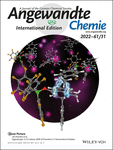
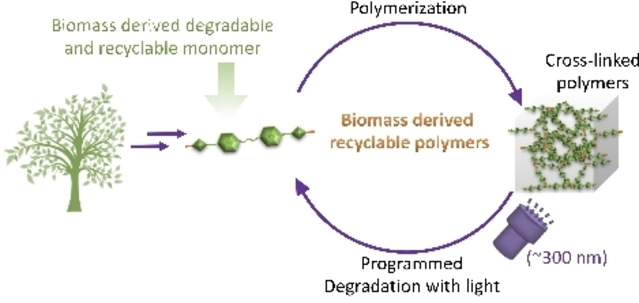

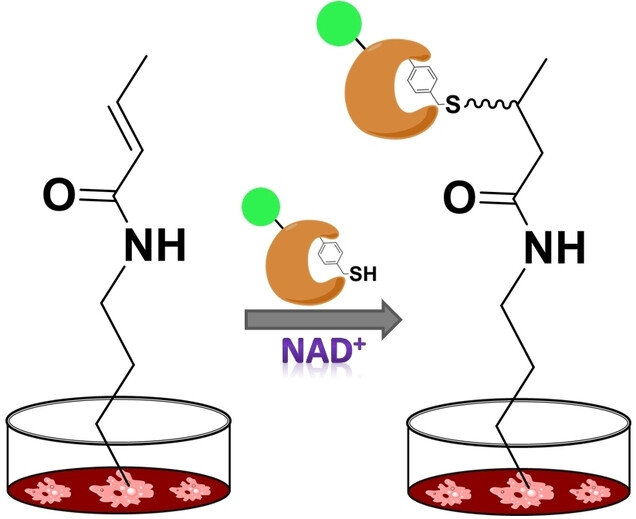


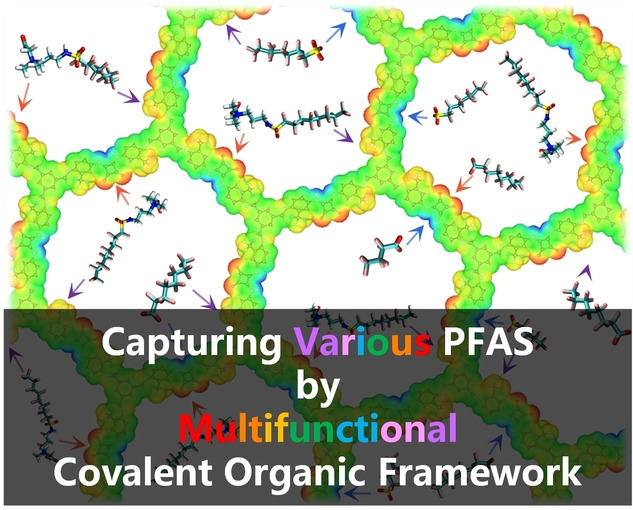
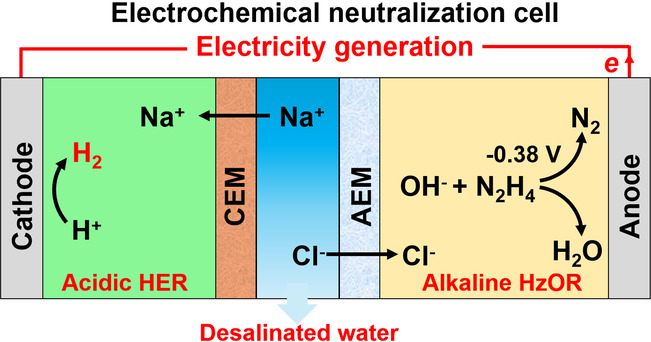
![“Rim-Differentiated” Pillar[6]arenes](/cms/asset/91a39241-7e1f-4429-a8f6-7f847ed00310/anie202204589-toc-0001-m.jpg)

